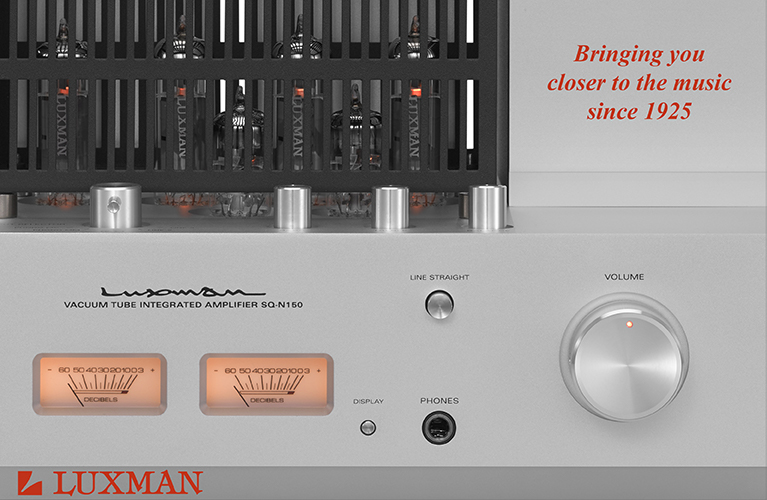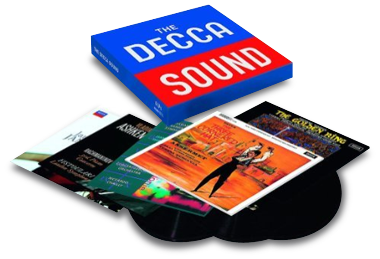 One of a few record labels that dominated the classical-music recording industry in the latter half of the 20th century, Decca had exclusive contracts with some of the best-known individual artists, conductors, and orchestras, and collaborative relationships with many others. In November, Decca released a 50-CD boxed set to celebrate their recorded legacy of over 60 years. The repackaging of older recordings in boxed sets is nothing new, and this one wouldn’t be noteworthy but for the fact that Decca has taken a tack different from the usual ploy of pulling off the shelf random recordings of headliner names. While the track list is littered with familiar names, the recordings included have been chosen to showcase the technical accomplishments of Decca’s storied engineering staff -- which is why the compilation is titled The Decca Sound. A collection of highlights has been released on a five-CD set, and six titles have been pressed on 180gm vinyl -- more on these LPs anon.
One of a few record labels that dominated the classical-music recording industry in the latter half of the 20th century, Decca had exclusive contracts with some of the best-known individual artists, conductors, and orchestras, and collaborative relationships with many others. In November, Decca released a 50-CD boxed set to celebrate their recorded legacy of over 60 years. The repackaging of older recordings in boxed sets is nothing new, and this one wouldn’t be noteworthy but for the fact that Decca has taken a tack different from the usual ploy of pulling off the shelf random recordings of headliner names. While the track list is littered with familiar names, the recordings included have been chosen to showcase the technical accomplishments of Decca’s storied engineering staff -- which is why the compilation is titled The Decca Sound. A collection of highlights has been released on a five-CD set, and six titles have been pressed on 180gm vinyl -- more on these LPs anon.
The CD set comes in a solid 5.5” cube. Each album is in a cardboard sleeve with a reproduction of the original cover art -- a solution that is economical, saves space, and is environmentally friendly. While some recordings were undoubtedly chosen for their commercial value, most were selected for their sonic, artistic, and historical importance. The recordings cover a variety of styles, including large-scale orchestral works (some with chorus), opera, chamber music, and solo piano. There’s even a disc titled Berlin Cabaret Songs. When an original album was of standard LP length (40 to 45 minutes), additional material is included to fill out the CD to 65 to 75 minutes. That’s a tremendous amount of music for a list price of $169 USD.
Also included is a 200-page booklet. Most of its pages are devoted to listing the albums, the works recorded, and, for each work, the musicians, the sound engineers, and the recording dates and locations. The remaining pages contain two essays, in English, French, and German. The second essay covers the music and artists and gives some rationale for the inclusion of each recording. With so much ground to cover, it flits from topic to topic, but it’s worth reading -- preferably in installments.
I found the first essay more interesting. Covering the evolution of the Decca sound from a technical perspective, it describes how Decca’s research for the Royal Navy in World War II financed the creation of a cutter head that could render frequencies up to 15,000Hz at a time when 7000Hz systems were being marketed as “high fidelity.” This development led to the Full Frequency Range Recording (ffrr) designation on Decca LPs in the late 1940s and ’50s. It goes on to talk about the label’s move toward stereo recording and the birth of the famous “Decca Tree” -- an arrangement of three microphones that managed to capture a spacious sound while retaining some degree of center focus -- and its various incarnations over the years. Also discussed is the importance of recording in good acoustical environments, and how the venues influenced the choices made by the engineers and the eventual sound of the recording. The essay concludes with a discussion of Decca’s migration to digital recording at the end of the 1970s. One fact worth mentioning is that the digital recorder Decca built in-house operated at 18 bits with a 48kHz sampling frequency. (The essay incorrectly calls this a 48kHz “bandwidth”; however, the maximum bandwidth of a system with a 48kHz sampling frequency is 24kHz.) These specifications are marginally better than the CD standard of 16-bit/44.1kHz.
CD sound quality
With recordings chosen from over six decades, some variability in sound quality is to be expected. I sampled two dozen or so of the discs and found the sound to range from good to very good, without ever reaching excellent or demonstration quality. Of the 50 discs, 29 contain material sourced from analog tape. They were free from the harsh, grainy, or brittle character that was common among some previous digital transfers of this same material. However, instrumental timbres were a bit muted and homogeneous -- more a caricature of analog sound than a precise reproduction of it. The natively digital recordings were, on average, a little better. When they erred, it was on the side of being a little too warm and rounded: always inoffensive, but sometimes less than engaging. Some albums -- such as Romantic Russia, with Georg Solti and the London Symphony Orchestra and Chorus (1966) -- had a healthy dose of the three-dimensionality and hall ambience for which Decca recordings were famous, but most had only a vague sense of space and depth, with no specific cues as to the positional relationships among instruments.
The Three Tenors in Concert (1990), included here, sounds pretty good, but the Mobile Fidelity Sound Lab edition (gold CD, MFSL UDCD 587) is much cleaner, more focused, and more articulate. In the new version, each tenor’s voice is smeared across a wider swath of the soundstage, and his characteristic vocal timbre is less distinct. The original digital LP of Luciano Pavarotti, Joan Sutherland, and Marilyn Horne’s Live from Lincoln Center (LP, London LDR72009) doesn’t sound extraordinary, but there’s somewhat greater instrumental and vocal separation than on the CD version included in this compilation. I was able to borrow a copy of Kyung-Wha Chung’s recording of Bruch’s Violin Concerto, with Rudolf Kempe and the Royal Philharmonic. The 1999 CD (Penguin Classics 289 460 620-2) had a slightly bigger sound than the one included in the boxed set, and I definitely heard more of the texture of the bow engaging the violin’s strings. The downside was a brighter, harder sound in the sections for full orchestra. Comparing the CDs in The Decca Sound with other Decca releases of similar material gave mixed results.
LP sound quality
I was a bit skeptical about the vinyl edition of The Decca Sound, as I wasn’t able to find any information about how the transfers were made. I’ve been disappointed in the past by LPs cut from CD masters -- they offer all the noise and distortion of the former along with the lopped-off high frequencies and flattened presentation of the latter. This time, however, I was pleasantly surprised. All six discs were remarkably quiet and free of extraneous ticks and pops. The albums of Janine Jansen (Beethoven and Bruch violin concertos, with Paavo Järvi conducting, respectively, the German Chamber Philharmonic of Bremen and the London Symphony) and Messiaen (Turangalîla Symphony; Riccardo Chailly, Royal Concertgebouw) both sounded very similar to their CD counterparts. These are both originally digital recordings, but I have no information about their native bit depth or sample rate. Falla’s The Three-Cornered Hat (Ernest Ansermet, Suisse Romande Orchestra) seemed larger than on the CD -- with greater and more precise separation between instruments. Vladimir Ashkenazy’s piano in his performance of Rachmaninoff’s Piano Concerto No.3 (Anatoule Fistoulari, London Symphony) revealed more of the sound of hammers hitting strings on LP than on CD. Both works on the Respighi LP (Lorin Maazel, Cleveland Orchestra) had greater openness and hall ambience than on CD, and The Pines of Rome crescendoed more effortlessly -- which I was definitely not expecting.
Side 2 of the selections from Wagner’s Ring (Georg Solti, Vienna Philharmonic) opens with Siegfried’s horn call in all its glorious brassiness -- only a pale imitation of the echoed part of this line is reproduced on the CD. It’s followed by “The Song of the Rhine Maidens,” which begins with the singers in the center of the soundstage -- seemingly behind the orchestra -- then panned between the channels to give the impression of them swimming about in the river. This selection appears to be absent from the CD version. The latter four LPs also rendered more satisfying instrumental timbres than the corresponding CDs.
The trouble with making the comparisons described in the preceding paragraphs is that they’re extremely system dependent. While good digital front ends often sound similar to each other, analog setups differ wildly. (Part of the appeal of analog to many audiophiles is the freedom to tune the sound to one’s own preferences.) I believe my analog front end to be fairly neutral, but the reasons I believe that would fill their own article. Unfortunately, I didn’t have the opportunity to hear the same LPs through a number of different systems, so I decided to take some measurements.
Vinyl analysis
There are few ways of objectively comparing a recording on LP to one on CD. One way is to look at dynamic range. Most people are well aware that the dynamic range of the CD is 96dB, and that of the very best LPs and playback systems is only about 70dB. That might seem the end of the story -- except that the signal/noise ratio of the analog master tapes, mixers, microphone preamplifiers, and microphones used to make the original analog recordings was likely not even 70dB, so greater dynamic range from the playback medium is not necessary. The other thing we can examine is the frequency spectrum -- i.e., how much energy is present at each frequency. A CD, being sampled at 44.1kHz, is incapable of preserving any frequency higher than 22.05kHz. Again, we run into the problem that the recording equipment of the 1950s and ’60s was unlikely to capture frequencies higher than that. There are motivations other than the capture of high frequencies for using a sample rate above 44.1kHz, but discussing them is beyond the scope of this article. It’s enough to know that those advantages aren’t something easily measurable by looking at the signal output. But rather than just throwing up our hands, let’s look at a few spectra and see if we can learn anything.
I tend to look for high-frequency content when the brass are playing, because those instruments are rich in upper harmonics, and often play loudly enough that those harmonics are visible above the noise floor. For the following analyses, I took one-second segments from the brassy bits of the cited recordings. I digitized the LPs by running the output of the phono preamplifier into the line inputs of my handy TASCAM DR-40 digital recorder, sampling at 96kHz. I applied a Hann window to the one-second sample, did a discrete Fourier transform on both channels, and averaged the results. The height of the graph at any point indicates the strength of that frequency relative to the strongest frequency in the analyzed segment.
Let’s start with the 1958 recording of Falla’s The Three-Cornered Hat.
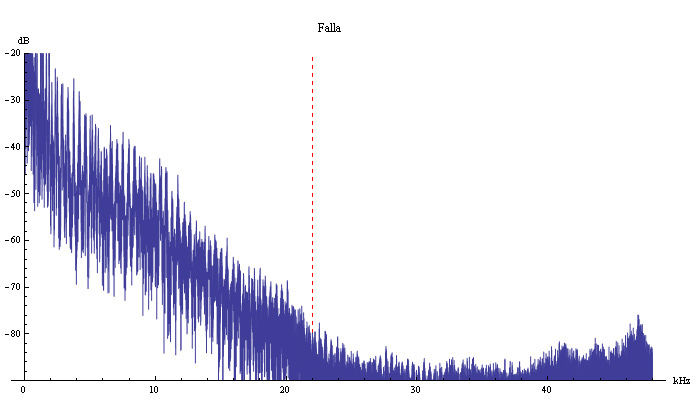
The dashed red line indicates the highest frequency that can be preserved by the CD medium’s 44.1kHz sample rate. The energy in the LP’s spectrum has rolled off quite a bit by that point, but there are some high-frequency spikes that may represent upper harmonics of the trumpet that’s playing during this segment. They are very close to the residual noise floor, but I didn’t see them when the brass weren’t playing. My findings were similar for the Rachmaninoff and Wagner LPs.
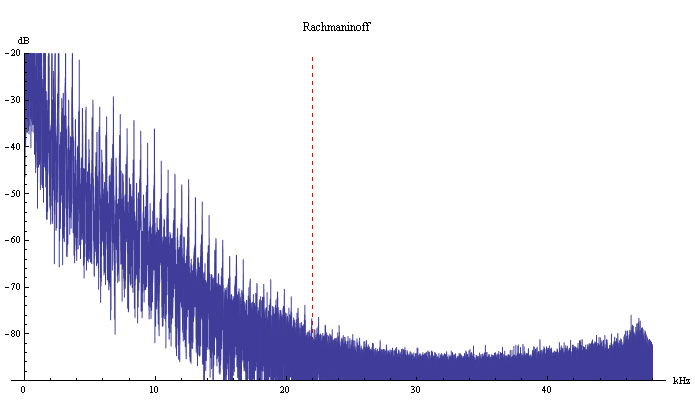
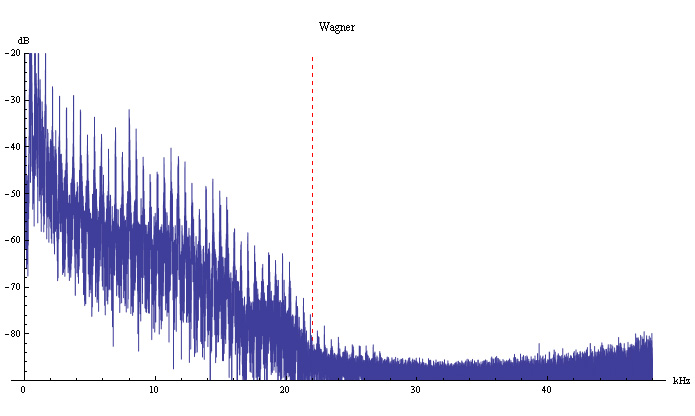
The Respighi album gave more definitive results.

Again, the dashed red line indicates the frequency limit of the CD medium. Unambiguously present here is content that blows way past that limit. The reason we see a regular series of spikes is that this one-second segment contains a straight-muted trumpet repeating a single pitch. The spikes are all upper harmonics of that pitch.
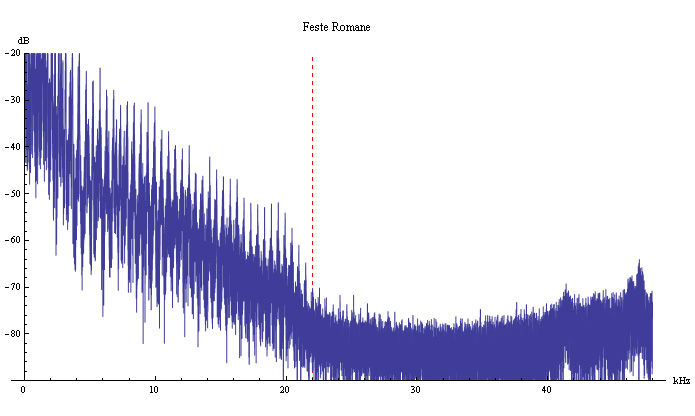
This segment was taken from one of the trumpet solos at the beginning of Respighi’s Feste Romane. An open trumpet has less upper-harmonic information than a straight-muted trumpet, but there’s still frequency content here that exceeds the CD’s limit.
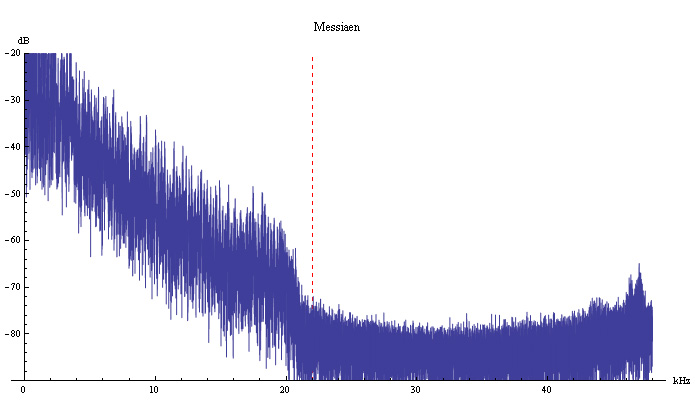
This digital recording, made in the early 1990s, shows a steep rolloff in the frequency content at around 20kHz -- typical behavior for a 44.1kHz-sampled system in which a proper antialiasing filter has been applied.

The Janine Jansen LP, of violin concertos by Beethoven and Britten, also appears to have been cut from a 44.1kHz source -- it shows the same steep rolloff as the Messiaen.
Summing up
I still have no concrete information about the sources used for these LPs. The analysis shows that the Respighi disc could not possibly have come from a CD master. Although the telltale signals are less strong, I am fairly confident in stating that the Falla, Rachmaninoff, and Wagner discs were also sourced from something of better than CD resolution. That doesn’t mean that the LPs were cut directly from the analog masters -- they may have been made from high-resolution digital transfers of those tapes. The digital masters for the Jansen and Messiaen LPs seem to have been limited to a 44.1kHz sample rate, and may or may not have been the same masters used for the CDs in the boxed set. Someone obviously decided that the set of LPs needed to include some modern recordings. Fortunately, these are two of the best-sounding candidates from the CD set.
I was rather hard on the 50-CD set at the beginning of this article. SoundStage! Hi-Fi is written for serious audiophiles, so I applied audiophile criteria to my evaluation. If you’re interested in sound quality that will test the limits of your equipment at both the micro and macro levels and present a holographic soundstage, The Decca Sound will leave you wanting. But if your interest is purely musical, this set is thoroughly enjoyable, and a heckuva value.
. . . S. Andrea Sundaram
andreas@soundstagenetwork.com






















